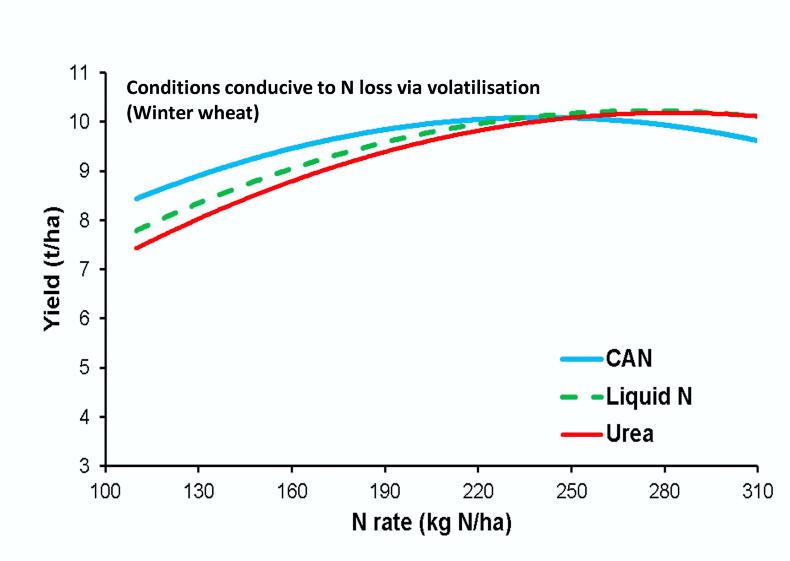While liquid nitrogen (N) (UAN = urea ammonium nitrate) has been used widely in the UK, Europe and further afield for many years, it is a relatively new product to many Irish growers and there is little research on its use for cereals under Irish conditions.
Liquid N has the potential to allow more even application of fertiliser, particularly where wide tramlines are being used, which can make the even application of granular fertiliser challenging.
It can also enable more even application on headlands. It will be easier to apply accurately when conditions are less than ideal for granular application (eg moderately windy conditions).
However, liquid N has a number of drawbacks. The solution contains 50% of the N as urea and 50% as ammonium nitrate.
In addition, there is a risk of crop scorch, particularly when applied at later growth stages
Work from abroad would indicate that N can be lost via ammonium volatilisation when the product is used in conditions conducive to volatilisation, such as warm dry conditions, which can make the product less efficient than CAN-type products.
This can be alleviated by the addition of urease inhibitor products to the liquid N.
In addition, there is a risk of crop scorch, particularly when applied at later growth stages, although this has not been a problem to-date at Oak Park. It can also be corrosive, which means careful cleaning of the sprayer is a necessity.
The research at Oak Park
The work in Oak Park aims to compare the efficiency of liquid N to that of CAN under typical Irish conditions. The efficiency of liquid N is being assessed on winter barley, spring barley and winter wheat.
At our trials event, we will show a winter wheat trial comparing liquid N to CAN, as well as to urea and two protected urea products, all at a range of fertiliser N rates.
Each N rate was applied in two equal applications during late tillering and early stem extension. Grain yield and protein content will be measured at harvest to determine the relative performance of different fertiliser types.

Figure 1. The relative efficacy in terms of winter wheat grain yield of three different N sources at different rates, in conditions conducive to volatilisation.
Results from previous years would indicate that liquid N can be as efficient as CAN. However, under conditions conducive to volatilisation (eg warm, dry conditions), liquid N can suffer losses of N, making it less efficient than CAN in those situations.
Assessing relative efficacy
This research will provide information on the relative efficiency of liquid N versus CAN and will also allow growers to make informed decisions on the use of liquid N on their crops.
While liquid nitrogen (N) (UAN = urea ammonium nitrate) has been used widely in the UK, Europe and further afield for many years, it is a relatively new product to many Irish growers and there is little research on its use for cereals under Irish conditions.
Liquid N has the potential to allow more even application of fertiliser, particularly where wide tramlines are being used, which can make the even application of granular fertiliser challenging.
It can also enable more even application on headlands. It will be easier to apply accurately when conditions are less than ideal for granular application (eg moderately windy conditions).
However, liquid N has a number of drawbacks. The solution contains 50% of the N as urea and 50% as ammonium nitrate.
In addition, there is a risk of crop scorch, particularly when applied at later growth stages
Work from abroad would indicate that N can be lost via ammonium volatilisation when the product is used in conditions conducive to volatilisation, such as warm dry conditions, which can make the product less efficient than CAN-type products.
This can be alleviated by the addition of urease inhibitor products to the liquid N.
In addition, there is a risk of crop scorch, particularly when applied at later growth stages, although this has not been a problem to-date at Oak Park. It can also be corrosive, which means careful cleaning of the sprayer is a necessity.
The research at Oak Park
The work in Oak Park aims to compare the efficiency of liquid N to that of CAN under typical Irish conditions. The efficiency of liquid N is being assessed on winter barley, spring barley and winter wheat.
At our trials event, we will show a winter wheat trial comparing liquid N to CAN, as well as to urea and two protected urea products, all at a range of fertiliser N rates.
Each N rate was applied in two equal applications during late tillering and early stem extension. Grain yield and protein content will be measured at harvest to determine the relative performance of different fertiliser types.

Figure 1. The relative efficacy in terms of winter wheat grain yield of three different N sources at different rates, in conditions conducive to volatilisation.
Results from previous years would indicate that liquid N can be as efficient as CAN. However, under conditions conducive to volatilisation (eg warm, dry conditions), liquid N can suffer losses of N, making it less efficient than CAN in those situations.
Assessing relative efficacy
This research will provide information on the relative efficiency of liquid N versus CAN and will also allow growers to make informed decisions on the use of liquid N on their crops.







 This is a subscriber-only article
This is a subscriber-only article










SHARING OPTIONS: